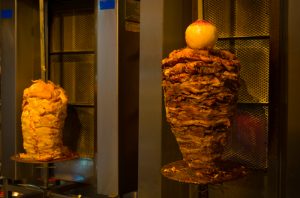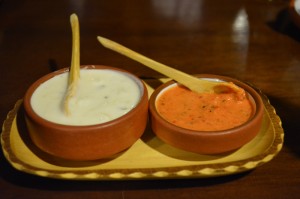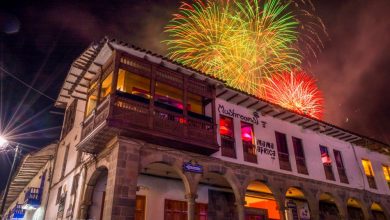Spits and Rollos Claim Cuzco

The streets of Cuzco’s colonial core are different every time you walk down them. Sure, the buildings stay much the same, whether you are looking at old pictures or remembering them from when you last visited them. They do vary over stretches of time, however: a new detail here, a different color there.
You need to only go into the museum of Casa Concha which houses the Yale Machu PIcchu collection and was an important place in its own right. It shows you some of the differences of that building in different times.
The quickest change you will see in restaurants and in foods offered. Even here, some are long lasting, but overall Cuzco has a very rapid turnover in its restaurants. Not only do they struggle for market share they also struggle to stand out, meet the needs of tourists, and offer new, distinctive, and tasty food. The barkers who try to draw people in are at the cutting edge of food in the Imperial city.
Over the last two or three years, one food in particular has had a rapid growth. In Cuzco its products are called rollos. That literally means rolls, but the food is not at all like sushi. Instead these a kebabs of one sort or another rolled in lavash bread, For all the world they look from the outside like a kind of burrito, or like what has been popularized in the United States as a wrap.
But they are different. The seasoning follows different aesthetics, as do the fillings. Although if you were to have an Arabic Taco from Puebla, tightly rolled in a flour tortilla and filled with seasoned meat (pork in this case) you might wonder. Still, neither the Mexican, the California, nor the US forms of burritos or wraps use yogurt, especially yogurt seasoned with garlic, like tzatziki sauce.

In fact, in the rollos different currents of food that poured out of the Middle East in different migrations comes together.

The rollos are basically Turkish in conception and if you look closely you will see, besides the lavash that is like a flour tortilla, something like the donner kebab that has claimed streets throughout Europe. Of course, this food, sometimes even served open-face like a taco and with thicker bread, more like pitas, is also found. Here you would be forgiven if they were to remind you of Greek Gyros or shawarmas from Jerusalem.
You would especially be in a good position if you noticed how common the falafel is as a filling. This fried chickpea ball gives you something to snack on in the cities of Israel, but is not just found there. Now it is found on many streets in Cuzco.
You walk down, say Plateros street and you see a small restaurant that emphasizes rollos. Up front they have the upright spit with grilling, seasoned meet, they slice off, heat and fold in lavash with salad and sauce to form a roll.
You keep going down the street and you will see another cafe that also has a small spit street-side to entice people. This ones’ barker as well as those of other places will offer rollos to you among their other dishes.
The kebab in lavash has become mainstream on Cuzco streets and soon will be as much part of the standard repertoire as tacos, and maybe lomo saltado are.
But the rollo has its own history of coming to Cuzco. For the longest time such things as felafel and shawarmas flourished only in the almost hidden corners of Israeli Cuzco where signs fill with the letters of contemporary Hebrew.
Cuzco has long been a destination for young Israelis, especially for those who have done their compulsory military service and now travel the world. Their’s is a place of their own culture, tourism, parties, and life. In the cafes and hotels that serve them versions of the Ottoman food of the levant have long found a home. But they had not crept out of the Chalon circuits. (In Cuzco Israelis are called Chalones because that is how their greeting, “shalom” sounds to Cuzco’s ears.)
In the last few years, following the growth of Kebabs as popular street food in Europe, restaurants specializing in rollos slowly appeared in Cuzco and the food itself has now left the domain of specialized places and moved into Cuzco mainstream.
The growth outside the Israeli domain probably has to do with the popularity of Turkish food in Europe, where Turks are

a major migrant group–they are the main immigrant group in Germany where they have a long presence and well established communities. The popularity among Europeans of kebabs is probably what made entrepreneurs in Cuzco open the first places specializing in rollos.
This is only the latest fold in the long history of engagement between the levant and Peru, as well as the rest of Latin America. When the Spanish invaded, they brought a very Arabic culture with them, one intimately related to the more recent Turkish street food that is conquering the world. They also brought a population that probably included many Moors. Indeed the veiled women of Lima and the use of the word Moro to describe a working class there, as well as coastal food itself such as cebiche and escabeche suggest the importance of this Moorish-Arab culture for early Peru.
More recently, Syrians and Lebanese immigrated to Latin America, including Peru, in large numbers and established enclaves. The people were commonly called in Spanish “Turcos” because they came from the Ottoman Empire, but in highland Peru, unlike elsewhere, they did not establish a public food culture. Their’s was private, more like that of today’s Israelis.
Curiously, they did claim a public presence for their food in other Latin American countries. For example in Puebla, Mexico you can easily find the very popular Tacos Arabes, Arab tacos, right there with the much earlier hybrid Arabic-Mexican mole poblano. And, throughout the republic you are offered tacos de al pastor where the meat is grilled on a spit like the Turkish kebabs and the Greek gyro. For some reason, such did not happen in highland Peru.
In Europe the Turks who migrated to work did build a public culture of food, the very popular kebab, especially the donner kebab. This is the new import from the levant that in its twisted route joins a food culture in Cuzco with Indigenous roots and much from Arab Al Andalus, Spain.




